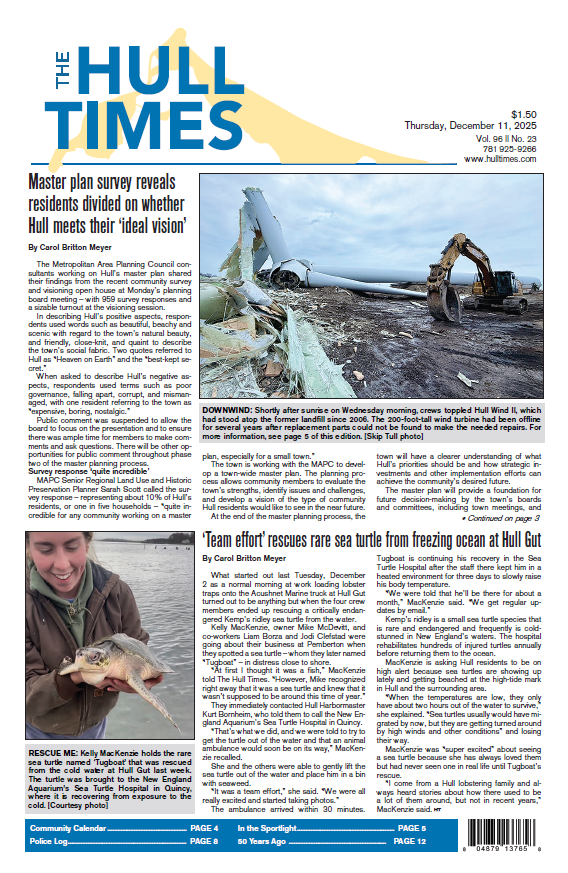Town seeks grants for beach management plan, study of upgrades to DPW, light plant
/By Carol Britton Meyer
The town is seeking grant funds to renovate the Department of Public Works and Hull Municipal Light Plant “critical facilities” through climate adaptation measures, and another grant to help pay for an update to Hull’s beach management plan.
A Coastal Zone Management grant awarded last year funded an evaluation of the two facilities – which are both in the floodplain – including an assessment of their climate vulnerability based on past scenarios as well as future projections. Both are considered to be undersized and beyond their serviceable life.
Climate Adaptation & Conservation Department Director Chris Krahforst presented an update about the current grant to the select board last week, as well as details about the town’s recent application for a CZM grant to update the beach management plan to include climate change resilience and adaptation, while addressing emerging beach management issues.
“The dunes and beach are important for flood control,” Krahforst said. “The idea is to develop a plan that protects [those resources]. If the CZM grant application isn’t successful, we need to find [a way to pay for it], even if it’s with [town funds],” he said.
BUILDING ISSUES. The Department of Public Works garage at West Corner and the Hull Municipal Lighting Plant on Edgewater Road are being assessed for potential renovations and flood protection.
A collaborative approach “with state agencies, residents, and town agents is necessary and would be greatly facilitated by a grant from this program,” according to Krahforst.
The town has also applied for a Phase 2 CZM Coastal Resilience Grant for continued funding for the light plant and DPW facilities evaluation.
These grants are awarded to municipalities and nonprofits to address coastal flooding, erosion, and sea level rise impacts.
Identifying site vulnerabilities
The report presented by Krahforst included information gained from site visits to both facilities and conversations with staff about the condition of the structures and the surrounding sites; equipment and storage; and physical vulnerabilities of the sites to past flood events and physical features that could cause vulnerability to future events.
For instance, the DPW barn at 9 Nantasket Avenue, was built in 1946 and experienced flooding reaching the garage doors twice during current director Chris Gardner’s time on the job. and two feet of flooding in the backyard during the 2018 winter storm Grayson, as well as flooding earlier this year.
With regard to the light plant on Edgewater Road – constructed around the turn of the last century, with renovations and repairs made in subsequent years – water rose into the parking lot, came up through the manhole, and created pooling in the garage storage area, with no damage to critical equipment, during the major March 2014 storm. The building is bordered by the road in front and the coastline in the rear.
The report recommends constructing any new buildings at the design flood elevation and limiting any critical uses on the first story below the design flood elevation, or floodproofing these spaces, and includes climate resiliency measures.
Design flood elevation refers to the minimum elevation to which a building must be elevated or floodproofed based on historic or projected flood information.
Schematic design stage
Phase 2, which could begin as early as this August depending on acquiring the second CZM grant, will likely focus on schematic design for the two facilities.
Meetings will be held with abutting property owners regarding the potential acquisition of adjacent parcels to potentially expand the footprint of the two existing parcels, with the goal of designing new or retrofitted climate-adapted facilities for both the DPW and HMLP. Other options also are being explored.
The project team presented one additional privately-owned site outside of the floodplain on Nantasket Avenue that would be large enough to house both facilities – the former Worrick Mansion property at 36 Nantasket Ave. There has been limited interest in this option, but it could be revisited.
On the other hand, Town Manager Jennifer Constable thinks that option should continue to be considered.
“We’re very limited when it comes to completely relocating” because so much of the town is in the floodplain and there’s limited land available, she said.
Pre-permitting conversations with state agencies will be held and an implementation plan detailing next steps for advancing the designs created, along with discussion about potential funding for the project.
“I would prefer to get these facilities out of the floodplain,” Krahforst said.
Another issue is how the town will pay for these projects. Krahforst explained that some state and federal funding may be available for planning on the state side and for construction and implementation on the federal side.
Like what you’re reading? Stay informed with a Hull Times subscription by clicking here.
Do you have an opinion to share? Click here to write a Letter to the Editor.













